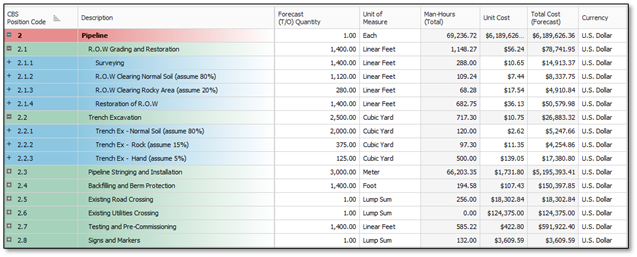Earned Value Management (EVM) remains one of the most effective ways to measure and manage a capital project’s true performance. Key takeaways:
- EVM connects schedule, cost, and performance metrics for better visibility.
- Historical best practices like WBS, rules of credit, and forecasting remain essential.
- Modern software now makes EVM accessible without dedicated specialists.
- EVM empowers proactive decision-making with real-time data.
Project Health Visibility Matters in Modern Capital Construction
With the complexity of today’s capital projects and the increased number of project stakeholders, understanding the health of a project at any point in time is more important than ever. Earned Value Management (EVM) is an established and accepted way of objectively reporting on a project’s health and has been adapted over the years so it can be implemented easily without teams of EVM experts.
Recently, InEight Product Director, John Upton, and I sat down together to discuss the amazing evolution of EVM, and how it can now be implemented at the activity, account, project and program level. What follows are the highlights of our discussion. Experience the full webinar recording here.
A Brief History and Evolution of Earned Value Management (EVM)
Originally, EVM was created as a way to objectively report on a project’s health. Developed by the US Government in the 1960’s, it was meant to help manage against cost and schedule overruns on large aerospace projects.
The EVM model has gone through several iterations and today can be implemented without EVM specialists, but it remains at its core a way to summarize how much work has been “earned” based on measurable progress.
Formula: Earned Value = Percent Complete x Budgeted Value.
Example: If we install 100 widgets at $10/widget, which equals a $1000 Budget.
- After installing 50 widgets, we will have, in theory, earned $500.
- We can then compare this earned value with our actual value, which may vary depending on who you ask!
- Accounting says we’ve spent half our budget, so we’re 50% complete.
- Scheduling tools say we’ve consumed 45% of our work force hours, so we’re 45% complete.
- The project manager feels we’re about 75% complete.
EVM helps shed light on the truth.
Earned Value Management Best Practices in Capital Construction
Create a detailed work breakdown structure (WBS)
This hierarchical approach summarizes costs and man-hours for each project task. Values from children “roll up” to their immediate and ultimate parents. It’s important to note that WBS should be a comprehensive list of all budgeted activities and costs. But don’t plan for the perfect execution; it rarely happens. Even though optimism bias suggests nothing will go wrong, plan for learning curves, weather delays and access restrictions based on work history, owner, geography, etc.
Use quantities as your common denominator
Quantities are the least common denominator on construction projects. all totals resolve to “unit values,” i.e., how much does it cost me to install one brick or pour one cubic yard of concrete?
Understand productivity variables and account for these in the WBS
If we know we will have a learning curve, longer hauls or more difficult work in certain areas that should be accounted for in the WBS.
Create rules of credit
These can provide a standard way of measuring progress for repetitive work (e.g., concrete slab pour)
Determine parent-child relationships
Determine how “children” affect their “parents.” Do they contribute to their parents based on their share of costs? How about on their share of workforce hours?
The following screenshot incorporates many of the best practices we just discussed. Notice how each piece of work is broken down, with appropriate quantities. Also, when expecting productivity differences, notice how these are laid out, including the estimator’s assumptions. By having such a layout in our EVM technology, we can determine how we want those project children’s activities to roll up and contribute to their project parents.

EVM in Real-World Applications
A typical pain point of accounting often occurs when a month will close and there will be a lag of a week or two to report on that month’s progress. That means that we may just be now learning about the actual cost of the work we performed in early June. Most customers would agree that if there is going to be a problem, let’s learn about it early on so we have a fighting chance of fixing it. EVM helps make this possible.
Understand EVM metrics before the shift begins. Project team members can put together a detailed plan for the day, including resources, hours and quantities installed to compare earned costs and workforce hours against actual values.

No need to wait for month-end close of accounting. Project teams can perform “what-if” analysis at the task level to determine the best way of attacking the work, which is much more proactive than reactive.
Catch trends before they become major issues. Because the data is available immediately, course correction can be made early on.
Contractors and owners can stay on the same page. Earned value metrics (rules of credit) can be agreed upon early in the project’s life cycle and can be used as a common language between the parties.
Forecasting with EVM: Understanding Key Calculations (Warning: Math!)
Forecasting is a way to intelligently predict what an activity, account or project will ultimately cost when it is complete. EAC, ETC and AV are common accepted terms used by the Project Management Institute (PMI). Unit values can be workforce hours and/or costs. Here’s how they are defined.
- Estimate at Completion (EAC): This is a prediction of the total amount that will be spent when the activity, account or project is finished.
- Estimate to Completion (ETC): This is a prediction of the remaining amount that will be spent when the activity, account or project is finished.
- Actual Value (AV): This is the amount that has already been spent.
- Moving further along, ETC = (Remaining Quantity) x Unit Value.
But where does the unit value come from? It can come from what was budgeted (CE or CB) for the work. Or it can come from commitments made to third parties to perform the work, from how the work is currently progressing (Average Production), or it can even be manually adjusted based on new information.
Applying Forecasting to Real-World Scenarios
How does all of this translate to a real project? Say for example an owner didn’t allow access to laydown yard, and our crews weren’t able to access key materials. Perhaps this issue has been resolved (we got the key!) and we don’t expect this to happen again. But what about new constraint scenarios? How does forecasting help us cope with these?
Say we have a one-time delay on site. In many cases, a one-time anomaly occurs. However, we don’t expect this to persist, so we can estimate the remaining work the way it was planned. Or the work is progressing differently than we had planned. Perhaps we’re using a different spread of equipment than we had budgeted for, or more costly (or cheaper) labor. In this case, we may want to use our average performance to predict the cost of the remaining work.
Perhaps we’ve encountered new constraints that weren’t accounted for. In this case, we may want to manually adjust our forecast. What if we’ve agreed to additional scope? New, approved scope can be included in the project’s current budget. Now we can forecast costs at complete by using our CB.
EVM and Forecasting Management: What to Look for in Modern Tools
When it comes time for you to consider upping your EVM and forecasting game in an effort to better manage your project outcomes, there are some key features that must be considered. First of all, we have integrated WBS creation capabilities. In some project management systems, budgets are summarized, and we lose detail into quantity and parent/child relationships. Then we have integrated contract management. This helps you leverage commitments made to measure earned value and to more accurately forecast costs at completion.
In addition, there’s planning at the activity level. Often, work is performed at the activity level, but many systems summarize up to broad-based accounts. What about change management? In that area, EVM and forecasts can best be based off current estimate (pending changes) and/or current budget (approved changes). Pending changes can be included/excluded from the analysis.
Finally, there is the ability to have collaboration on forecasts. In this way, project team members can collectively review and collaborate on forecasts prior to pushing these out to the broader team as “live” forecasts.
Throughout all the changes EVM has been through, it continues to hold its place as an established and accepted way of objectively reporting on a project’s health, easily implemented without teams of EVM experts, yielding better project outcomes more reliably.
InEight provides integrated project controls solutions that connect forecasting, earned value management (EVM), and cost management across every phase of execution. Our platform delivers real-time insights that strengthen collaboration, improve forecasting accuracy, and keep projects on track. Modern EVM tools will transform your project visibility.




